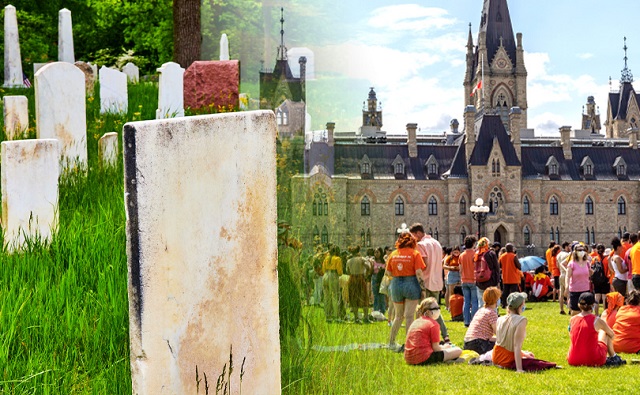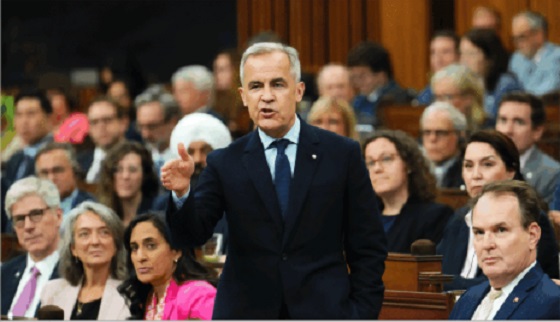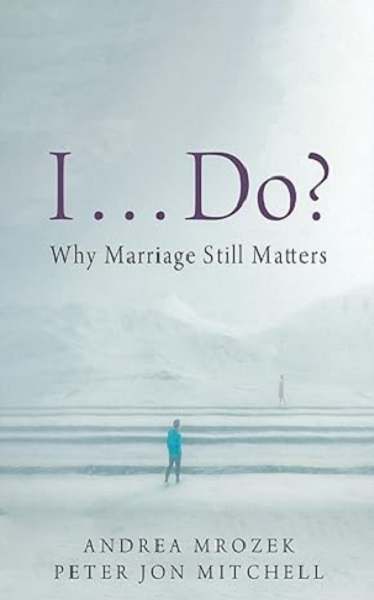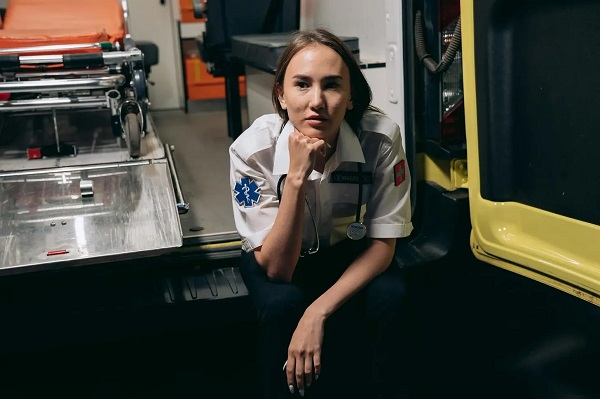National
Despite claims of 215 ‘unmarked graves,’ no bodies have been found at Canadian residential school

From LifeSiteNews
Over 100 churches have been burned or vandalized since the Trudeau government and mainstream media promulgated, without any physical evidence, the narrative that mass ‘unmarked graves’ had been discovered at Kamloops Indian Residential School.
Canada’s Department of Crown-Indigenous Relations has confirmed it has spent millions searching for “unmarked graves” at a now-closed residential school once run by the Catholic Church, despite the fact that no human remains have been found.
In total, some $7.9 million was earmarked for a search of unmarked Indian Residential School graves in Kamloops, British Columbia. According to the spokeswoman for the Crown-Indigenous Relations, Carolane Gratton, the community got the money “for field work, records searches and to secure the Residential School grounds.”
“Details of initiatives taken by Tk’emlups te Secwepemc First Nation are best directed to the community,” noted Gratton.
To date, the Department of Crown-Indigenous Relations has not given a financial accounting under the Access To Information Act as to where the money went. According to the Tk’emlups te Secwepemc First Nation, it “continues to grieve children that are in our care and are focused on the scientific work that needs to be done,” but made no mention of the $7.9 million.
In 2021 and 2022, the mainstream media ran with inflammatory and dubious claims that hundreds of children were buried and disregarded by Catholic priests and nuns who ran some of the schools.
The Tk’emlups te Secwepemc First Nation was more or less the reason there was a large international outcry in 2021, when it claimed it had found 215 “unmarked graves” of kids at the Kamloops Residential School. The claims of remains, however, were not backed by physical evidence, but were rather disturbances in the soil picked up by ground-penetrating radar.
The money given to the First Nation was done so to find the “heartbreaking truth” of the residential school system, according to a 2022 Indian Residential School Sites: Unmarked Burials department briefing note.
“Our thoughts are with survivors, their families and communities as the heartbreaking truth about Residential Schools’ unmarked burials continues to be unveiled,” read the note.
“Funding is available to support communities, survivors and their families on their healing journey through researching, locating and memorializing those children who died while attending Indian Residential Schools.”
Canadian indigenous residential schools, while run by both the Catholic Church and other Christian churches, were mandated and set-up by the federal government and ran from the late 19th century until the last school closed in 1996.
While there were indeed some Catholics who committed serious abuses against native children, the past wrongs led to widespread anti-Catholic sentiment, which boiled over in the summer of 2021 after the discovery of the 215 so-called “unmarked” graves in Kamloops.
While some children did die at the once-mandatory boarding schools, evidence has revealed that many of the children tragically passed away as a result of unsanitary conditions due to the federal government, not the Catholic Church, failing to properly fund the system.
No human remains have been found
Soon after the Kamloops announcement in 2021, other regions claimed the presence of “unmarked graves,” which prompted Canada’s House of Commons under Liberal Prime Minister Justin Trudeau, with the help of all other parties including the Conservatives, to declare the residential school program a “genocide” despite the lack of evidence.
The reality is that to date, no human remains have been found at the Kamloops site or other sites.
In fact, in August 2023, the Pine Creek Residential School, located in Pine Creek, Manitoba, underwent a four-week excavation and yielded no remains.
The excavation was led by a First Nation’s tribe called Minegoziibe Ashinabe, and came after a total of 14 abnormalities were found at the former school by ground-penetrating radar.
There have been other excavations conducted at residential schools that have likewise turned up no human remains.
Since the spring of 2021, over 100 churches, mostly Catholic, have been burned or vandalized across Canada. The attacks on the churches came shortly after the “unmarked graves” narrative began.
Despite the church burnings, the federal government under Trudeau has done nothing substantial to bring those responsible to justice or to stem the root cause of the burnings.
“I think Canadians have seen with horror those unmarked graves across the country and realize that what happened decades ago isn’t part of our history, it is an irrefutable part of our present,” Trudeau had earlier remarked to reporters.
The unmarked graves controversy also spurred a Senate committee in 2023 to claim that anyone who questions the graves is engaged in “Residential School denialism.”
“Denialism serves to distract people from the horrific consequences of Residential Schools and the realities of missing children, burials and unmarked graves,” said a Senate Indigenous peoples committee report titled Honouring The Children Who Never Came Home.
The Senate committee report said that the Canadian government should “take every action necessary to combat the rise of Residential School denialism.”
Jordan Peterson tells Pope Francis to ‘take note’
Responding to reports about the Trudeau government spending nearly $8 million without finding a single body, renowned anti-woke Canadian psychologist Jordan Peterson took a shot at Pope Francis.
“Pope Francis take note @Pontifex,” wrote Peterson on X (formerly Twitter) last Thursday.
Pope Francis take note @Pontifex https://t.co/YAyKDtMa4A
— Dr Jordan B Peterson (@jordanbpeterson) May 9, 2024
Peterson’s remarks likely came in light of the fact that Francis visited Canada in the summer of 2022 for the purpose of apologizing for churchmen’s role in the operation of the residential school program.
During his July 2022 trip, Francis visited First Nations in Alberta and Quebec. While in Quebec, he seemed to join in on a pagan “smudging” ritual before giving a lengthy speech where he conveyed “deep shame and sorrow” for the role played by Catholic Church members in government-funded residential school abuses.
While Francis seemed to go along with the mainstream narrative regarding residential schools, others have spoken out.
Last year, retired Bishop of Calgary, Frederick Henry, blasted the blatant “lie” that thousands of missing indigenous children who attended residential schools run by the Catholic Church were somehow “clandestinely” murdered by “Catholic priests and nuns.”
The founder of the National Post, Conrad Black, also made similar statements as Henry in an opinion piece for his former paper, calling the entire narrative a “fraud.”
Business
Mark Carney’s Fiscal Fantasy Will Bankrupt Canada

By Gwyn Morgan
Mark Carney was supposed to be the adult in the room. After nearly a decade of runaway spending under Justin Trudeau, the former central banker was presented to Canadians as a steady hand – someone who could responsibly manage the economy and restore fiscal discipline.
Instead, Carney has taken Trudeau’s recklessness and dialled it up. His government’s recently released spending plan shows an increase of 8.5 percent this fiscal year to $437.8 billion. Add in “non-budgetary spending” such as EI payouts, plus at least $49 billion just to service the burgeoning national debt and total spending in Carney’s first year in office will hit $554.5 billion.
Even if tax revenues were to remain level with last year – and they almost certainly won’t given the tariff wars ravaging Canadian industry – we are hurtling toward a deficit that could easily exceed 3 percent of GDP, and thus dwarf our meagre annual economic growth. It will only get worse. The Parliamentary Budget Officer estimates debt interest alone will consume $70 billion annually by 2029. Fitch Ratings recently warned of Canada’s “rapid and steep fiscal deterioration”, noting that if the Liberal program is implemented total federal, provincial and local debt would rise to 90 percent of GDP.
This was already a fiscal powder keg. But then Carney casually tossed in a lit match. At June’s NATO summit, he pledged to raise defence spending to 2 percent of GDP this fiscal year – to roughly $62 billion. Days later, he stunned even his own caucus by promising to match NATO’s new 5 percent target. If he and his Liberal colleagues follow through, Canada’s defence spending will balloon to the current annual equivalent of $155 billion per year. There is no plan to pay for this. It will all go on the national credit card.
This is not “responsible government.” It is economic madness.
And it’s happening amid broader economic decline. Business investment per worker – a key driver of productivity and living standards – has been shrinking since 2015. The C.D. Howe Institute warns that Canadian workers are increasingly “underequipped compared to their peers abroad,” making us less competitive and less prosperous.
The problem isn’t a lack of money; it’s a lack of discipline and vision. We’ve created a business climate that punishes investment: high taxes, sluggish regulatory processes, and politically motivated uncertainty. Carney has done nothing to reverse this. If anything, he’s making the situation worse.
Recall the 2008 global financial meltdown. Carney loves to highlight his role as Bank of Canada Governor during that time but the true credit for steering the country through the crisis belongs to then-prime minister Stephen Harper and his finance minister, Jim Flaherty. Facing the pressures of a minority Parliament, they made the tough decisions that safeguarded Canada’s fiscal foundation. Their disciplined governance is something Carney would do well to emulate.
Instead, he’s tearing down that legacy. His recent $4.3 billion aid pledge to Ukraine, made without parliamentary approval, exemplifies his careless approach. And his self-proclaimed image as the experienced technocrat who could go eyeball-to-eyeball against Trump is starting to crack. Instead of respecting Carney, Trump is almost toying with him, announcing in June, for example that the U.S. would pull out of the much-ballyhooed bilateral trade talks launched at the G7 Summit less than two weeks earlier.
Ordinary Canadians will foot the bill for Carney’s fiscal mess. The dollar has weakened. Young Canadians – already priced out of the housing market – will inherit a mountain of debt. This is not stewardship. It’s generational theft.
Some still believe Carney will pivot – that he will eventually govern sensibly. But nothing in his actions supports that hope. A leader serious about economic renewal would cancel wasteful Trudeau-era programs, streamline approvals for energy and resource projects, and offer incentives for capital investment. Instead, we’re getting more borrowing and ideological showmanship.
It’s no longer credible to say Carney is better than Trudeau. He’s worse. Trudeau at least pretended deficits were temporary. Carney has made them permanent – and more dangerous.
This is a betrayal of the fiscal stability Canadians were promised. If we care about our credit rating, our standard of living, or the future we are leaving our children, we must change course.
That begins by removing a government unwilling – or unable – to do the job.
Canada once set an economic example for others. Those days are gone. The warning signs – soaring debt, declining productivity, and diminished global standing – are everywhere. Carney’s defenders may still hope he can grow into the job. Canada cannot afford to wait and find out.
The original, full-length version of this article was recently published in C2C Journal.
Gwyn Morgan is a retired business leader who was a director of five global corporations.
Business
Carney Liberals quietly award Pfizer, Moderna nearly $400 million for new COVID shot contracts

From LifeSiteNews
Carney’s Liberal government signed nearly $400 million in contracts with Pfizer and Moderna for COVID shots, despite halted booster programs and ongoing delays in compensating Canadians for jab injuries.
Prime Minister Mark Carney has awarded Pfizer and Moderna nearly $400 million in new COVID shot contracts.
On June 30th, the Liberal government quietly signed nearly $400 million contracts with vaccine companies Pfizer and Moderna for COVID jabs, despite thousands of Canadians waiting to receive compensation for COVID shot injuries.
The contracts, published on the Government of Canada website, run from June 30, 2025, until March 31, 2026. Under the contracts, taxpayers must pay $199,907,418.00 to both companies for their COVID shots.
Notably, there have been no press releases regarding the contracts on the Government of Canada website nor from Carney’s official office.
Additionally, the contracts were signed after most Canadians provinces halted their COVID booster shot programs. At the same time, many Canadians are still waiting to receive compensation from COVID shot injuries.
Canada’s Vaccine Injury Support Program (VISP) was launched in December 2020 after the Canadian government gave vaccine makers a shield from liability regarding COVID-19 jab-related injuries.
There has been a total of 3,317 claims received, of which only 234 have received payments. In December, the Canadian Department of Health warned that COVID shot injury payouts will exceed the $75 million budget.
The December memo is the last public update that Canadians have received regarding the cost of the program. However, private investigations have revealed that much of the funding is going in the pockets of administrators, not injured Canadians.
A July report by Global News discovered that Oxaro Inc., the consulting company overseeing the VISP, has received $50.6 million. Of that fund, $33.7 million has been spent on administrative costs, compared to only $16.9 million going to vaccine injured Canadians.
Furthermore, the claims do not represent the total number of Canadians injured by the allegedly “safe and effective” COVID shots, as inside memos have revealed that the Public Health Agency of Canada (PHAC) officials neglected to report all adverse effects from COVID jabs and even went as far as telling staff not to report all events.
The PHAC’s downplaying of jab injuries is of little surprise to Canadians, as a 2023 secret memo revealed that the federal government purposefully hid adverse effect so as not to alarm Canadians.
The secret memo from former Prime Minister Justin Trudeau’s Privy Council Office noted that COVID jab injuries and even deaths “have the potential to shake public confidence.”
“Adverse effects following immunization, news reports and the government’s response to them have the potential to shake public confidence in the COVID-19 vaccination rollout,” read a part of the memo titled “Testing Behaviourally Informed Messaging in Response to Severe Adverse Events Following Immunization.”
Instead of alerting the public, the secret memo suggested developing “winning communication strategies” to ensure the public did not lose confidence in the experimental injections.
Since the start of the COVID crisis, official data shows that the virus has been listed as the cause of death for less than 20 children in Canada under age 15. This is out of six million children in the age group.
The COVID jabs approved in Canada have also been associated with severe side effects, such as blood clots, rashes, miscarriages, and even heart attacks in young, healthy men.
Additionally, a recent study done by researchers with Canada-based Correlation Research in the Public Interest showed that 17 countries have found a “definite causal link” between peaks in all-cause mortality and the fast rollouts of the COVID shots, as well as boosters.
Interestingly, while the Department of Health has spent $16 million on injury payouts, the Liberal government spent $54 million COVID propaganda promoting the shot to young Canadians.
The Public Health Agency of Canada especially targeted young Canadians ages 18-24 because they “may play down the seriousness of the situation.”
-

 Fraser Institute1 day ago
Fraser Institute1 day agoBefore Trudeau average annual immigration was 617,800. Under Trudeau number skyrocketted to 1.4 million annually
-

 MAiD1 day ago
MAiD1 day agoCanada’s euthanasia regime is already killing the disabled. It’s about to get worse
-

 Frontier Centre for Public Policy1 day ago
Frontier Centre for Public Policy1 day agoNew Book Warns The Decline In Marriage Comes At A High Cost
-

 Business1 day ago
Business1 day agoPrime minister can make good on campaign promise by reforming Canada Health Act
-

 Addictions1 day ago
Addictions1 day ago‘Over and over until they die’: Drug crisis pushes first responders to the brink
-

 International1 day ago
International1 day agoChicago suburb purchases childhood home of Pope Leo XIV
-

 Daily Caller1 day ago
Daily Caller1 day agoUSAID Quietly Sent Thousands Of Viruses To Chinese Military-Linked Biolab
-

 Energy1 day ago
Energy1 day agoLNG Export Marks Beginning Of Canadian Energy Independence



